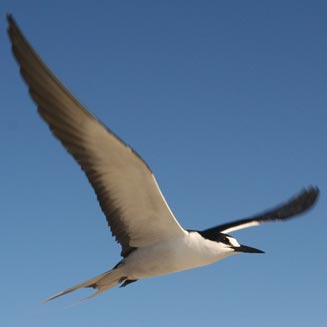|
Sterna fuscata (Sooty tern)
Roetsterretjie [Afrikaans]; Bonte stern [Dutch]; Sterne
fuligineuse [French]; Ru▀seeschwalbe [German]; Gaivina-de-dorso-preto
[Portuguese]
Life
> Eukaryotes >
Opisthokonta
> Metazoa (animals) >
Bilateria >
Deuterostomia > Chordata >
Craniata > Vertebrata (vertebrates) > Gnathostomata (jawed
vertebrates) > Teleostomi (teleost fish) > Osteichthyes (bony fish) > Class:
Sarcopterygii (lobe-finned
fish) > Stegocephalia (terrestrial
vertebrates) > Tetrapoda
(four-legged vertebrates) > Reptiliomorpha > Amniota >
Reptilia (reptiles) >
Romeriida > Diapsida > Archosauromorpha > Archosauria >
Dinosauria
(dinosaurs) > Saurischia > Theropoda (bipedal predatory dinosaurs) >
Coelurosauria > Maniraptora > Aves
(birds) > Order: Charadriiformes
> Family: Laridae > Genus: Sterna
 |
|
|
Sooty tern, Tern Island, Hawaii. [photo
Duncan Wright,
US Fish and Wildlife Service] |
|
Distribution and habitat
The world's must abundant tern, it breeds on many tropical
islands, including Europa and Tern Islands in the Mozambique channel. It is a
fairly common summer visitor to the area off the coast of Mozambique, although
rarely sighted near land, it occasionally strays to eastern
South Africa and southern Zimbabwe.
Movements and migrations
Disperses after breeding and is mainly recorded
in southern African waters in summer.
Food
Mainly eats fish and aquatic invertebrates, doing most of
its foraging by plucking prey from the water surface, or alternatively hawking
flying fish aerially. The following food items have been recorded
in its diet:
- Fish
- Invertebrates
- cephalopods
- hydrozoans
- fish
- crustaceans
Threats
Not threatened, in fact it is thought to have a global
population of approximately 14.5 million individuals.
References
-
Hockey PAR, Dean WRJ and Ryan PG 2005. Roberts
- Birds of southern Africa, VIIth ed. The Trustees of the John Voelcker
Bird Book Fund, Cape Town.
|
